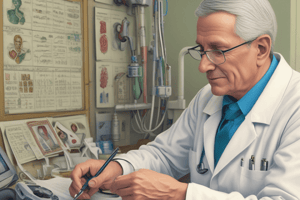Podcast
Questions and Answers
What is the main purpose of the chief complaint in a health history?
What is the main purpose of the chief complaint in a health history?
- To determine the patient's family history
- To perform a review of systems
- To identify the patient's past medical history
- To identify the reason for the patient's visit (correct)
Which of the following is an example of subjective data?
Which of the following is an example of subjective data?
- A patient's laboratory test results
- A patient's blood pressure reading
- A patient's heart rate
- A patient's report of chest pain (correct)
What is the purpose of the review of systems?
What is the purpose of the review of systems?
- To perform a physical examination
- To determine the patient's past medical history
- To identify any other symptoms or problems the patient is experiencing (correct)
- To identify the patient's family history
What is the difference between sensitivity and specificity in evaluating diagnostic tests?
What is the difference between sensitivity and specificity in evaluating diagnostic tests?
What is the purpose of the SOAP note?
What is the purpose of the SOAP note?
What is the purpose of the US Preventative Service Task Force?
What is the purpose of the US Preventative Service Task Force?
What is the purpose of the clinical reasoning process?
What is the purpose of the clinical reasoning process?
What is the purpose of evaluating clinical evidence?
What is the purpose of evaluating clinical evidence?
What is the primary concern of the 42-year-old female mathematician in the initial visit with her third rheumatology provider?
What is the primary concern of the 42-year-old female mathematician in the initial visit with her third rheumatology provider?
What is the purpose of using the FIFE model in the patient's care?
What is the purpose of using the FIFE model in the patient's care?
What does the FIFE model stand for?
What does the FIFE model stand for?
What is the primary goal of the clinician in using the FIFE model?
What is the primary goal of the clinician in using the FIFE model?
What is the term for a question that pushes the patient to answer in a certain way?
What is the term for a question that pushes the patient to answer in a certain way?
What is the 59-year-old patient's primary concern in the visit with his primary care provider?
What is the 59-year-old patient's primary concern in the visit with his primary care provider?
What interviewing technique is employed by the clinician in the second scenario?
What interviewing technique is employed by the clinician in the second scenario?
What type of finding relies on the patient's report?
What type of finding relies on the patient's report?
What is an example of an objective finding in a patient?
What is an example of an objective finding in a patient?
What is the purpose of the clinician's response 'Just like?' in the second scenario?
What is the purpose of the clinician's response 'Just like?' in the second scenario?
What is the purpose of percussion in a physical examination?
What is the purpose of percussion in a physical examination?
What is the primary benefit of using active listening techniques like echoing?
What is the primary benefit of using active listening techniques like echoing?
What kind of question allows a spectrum of responses?
What kind of question allows a spectrum of responses?
What is the difference between echoing and encouraging with continuers?
What is the difference between echoing and encouraging with continuers?
What should the clinician prioritize when using the FIFE model in patient care?
What should the clinician prioritize when using the FIFE model in patient care?
What is the primary difference between subjective and objective findings?
What is the primary difference between subjective and objective findings?
What is the name of the technique that involves gentle pressure with the fingers to identify skin elevation or temperature changes?
What is the name of the technique that involves gentle pressure with the fingers to identify skin elevation or temperature changes?
What should the clinician begin with when examining a patient with symptoms of fatigue, hunger, and cold feet?
What should the clinician begin with when examining a patient with symptoms of fatigue, hunger, and cold feet?
What type of question should clinicians avoid using during a medical interview?
What type of question should clinicians avoid using during a medical interview?
What is the term for using the third fingers of each hand to determine the health of internal organs?
What is the term for using the third fingers of each hand to determine the health of internal organs?
When performing a physical examination, what is the recommended order to optimize patient comfort and ensure nothing is missed?
When performing a physical examination, what is the recommended order to optimize patient comfort and ensure nothing is missed?
What is the component of the past history that a physician assistant omitted when taking a patient's history?
What is the component of the past history that a physician assistant omitted when taking a patient's history?
What is the medical term for obesity?
What is the medical term for obesity?
What is the CAGE questionnaire used to evaluate?
What is the CAGE questionnaire used to evaluate?
What is the primary focus of the physical examination?
What is the primary focus of the physical examination?
What is the purpose of obtaining information about childhood illnesses and adult illnesses during a patient's history?
What is the purpose of obtaining information about childhood illnesses and adult illnesses during a patient's history?
What is the definition of overweight in medical terms?
What is the definition of overweight in medical terms?
Why is it important to obtain information about immunizations during a patient's history?
Why is it important to obtain information about immunizations during a patient's history?
What is the primary purpose of the CAGE questionnaire?
What is the primary purpose of the CAGE questionnaire?
What is the recommended order for a physician assistant to take a patient's history?
What is the recommended order for a physician assistant to take a patient's history?
What is the purpose of the CAGE questionnaire?
What is the purpose of the CAGE questionnaire?
What is the primary concern for the physician assistant (PA) in the given scenario?
What is the primary concern for the physician assistant (PA) in the given scenario?
What is the physician assistant (PA) suspected of failing to do?
What is the physician assistant (PA) suspected of failing to do?
What is the possible underlying condition that the physician assistant (PA) should consider?
What is the possible underlying condition that the physician assistant (PA) should consider?
What should the physician assistant (PA) do first in this scenario?
What should the physician assistant (PA) do first in this scenario?
What is not a purpose of the CAGE questionnaire?
What is not a purpose of the CAGE questionnaire?
What is the patient's chief complaint in the given scenario?
What is the patient's chief complaint in the given scenario?
Why did the patient present to the clinic?
Why did the patient present to the clinic?
Flashcards are hidden until you start studying
Study Notes
Health History Components
- Identifying patient information: gathering data about the patient, including their chief complaint, medical history, and personal and social history
- Source of history: identifying the source of the patient's information, such as the patient themselves, family members, or medical records
- Chief complaint: the patient's primary reason for seeking medical attention
- History of present illness: a detailed description of the patient's symptoms, including their onset, duration, and severity
- Past medical history: a review of the patient's previous medical conditions, illnesses, and surgeries
- Family history: a review of the patient's family medical history, including genetic disorders and illnesses
- Personal and social history: a review of the patient's lifestyle, including their occupation, diet, and social habits
- Review of Systems: a review of the patient's symptoms and medical history, organized by body system
Subjective vs. Objective Data
- Subjective data: information provided by the patient, including their symptoms, feelings, and experiences
- Objective data: information gathered by the clinician through observation, examination, and laboratory tests
Physical Examination
- Setting the stage: preparing the patient and the environment for the examination
- Preparing equipment: gathering necessary equipment, such as a stethoscope and blood pressure cuff
- Making the patient comfortable: ensuring the patient's physical and emotional comfort during the examination
- Suggested Head-to-Toe Physical Examination: a systematic approach to examining the patient's body, from head to toe
- Documenting findings: recording the results of the examination, including any abnormalities or concerns
Clinical Reasoning, Assessment, and Plan
- Clinical reasoning: the process of gathering and interpreting information to develop a diagnosis and treatment plan
- Gathering initial patient information: collecting data through the health history and physical examination
- Organizing and interpreting information: analyzing the data to identify patterns and relationships
- Generating hypotheses: developing potential diagnoses based on the data
- Testing hypotheses: evaluating the hypotheses through further examination, testing, and consultation
- Planning the diagnostic and treatment strategy: developing a plan to diagnose and treat the patient's condition
SOAP Notes
- Subjective: documenting the patient's subjective data, including their symptoms and experiences
- Objective: documenting the patient's objective data, including examination findings and laboratory results
- Assessment: documenting the clinician's interpretation of the data, including the diagnosis and treatment plan
- Plan: documenting the plan for further diagnosis and treatment, including medications, procedures, and follow-up care
Health Maintenance and Screening
- US Preventative Service Task Force: a organization that recommends screening and preventive services for various populations
- Screening recommendations: guidelines for screening tests, such as mammograms and colonoscopies
- BMI assessment and diabetes screening: assessing the patient's body mass index and screening for diabetes
- Substance use disorders screening: screening for substance abuse and dependence
- Screening for intimate partner violence and elder abuse: screening for signs of abuse and neglect
- STI screening: screening for sexually transmitted infections
- HIV screening: screening for HIV infection
- Immunizations: administering vaccinations to prevent infectious diseases
Evaluating Clinical Evidence
- Evaluating diagnostic tests: assessing the validity and reliability of diagnostic tests
- Validity: the accuracy of a diagnostic test in identifying a disease or condition
- Sensitivity: the ability of a diagnostic test to detect a disease or condition in people who have it
- Specificity: the ability of a diagnostic test to exclude a disease or condition in people who do not have it
- Critical appraisal of clinical evidence: evaluating the quality and relevance of research evidence to inform clinical practice
Studying That Suits You
Use AI to generate personalized quizzes and flashcards to suit your learning preferences.




